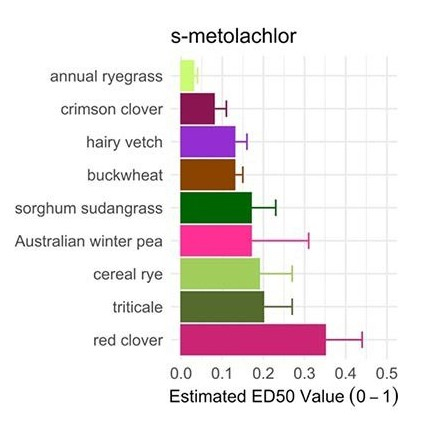By John Wallace
Soil-applied residual herbicides commonly used in corn and soybean programs have the potential to persist in soil at levels capable of limiting establishment of cover crops. Successful integration of residual herbicides and emerging cover cropping practices requires consideration of several moving parts. This article provides a brief update on our current research activities that aim to improve BMPs for limiting the impact of residual herbicide use on cover crop establishment.
Though we have a good understanding of whether residual herbicides are 'short' versus 'long' lived in soil, their persistence at levels capable of injuring cover crops under field conditions can vary widely based on differences in soil (texture, pH, organic matter) and environmental (precipitation, soil temperature) factors. Furthermore, cover crops are increasingly employed in a number of different ways within field crop rotations that influence the length of time from herbicide application to cover crop seeding, ranging from interseeding cover crops early in the corn growing season to post-harvest establishment methods.
For the past several years, we have conducted field trials to evaluate residual herbicide carryover potential to cover crops interseeded into corn at approximately the V5 growth stage, or approximately six weeks after herbicide application. Our field trials evaluated residual corn herbicides alone or in jug-mixed products and focused primarily on medium red clover and annual ryegrass, which are cover crop species well-adapted to interseeded systems. However, growing interest in employing diverse cover crop mixtures has generated many unknowns when it comes to residual herbicide injury. In response, we are taking a different research approach that should help address these knowledge gaps.
The probability of herbicide carryover injury to cover crops is not solely a function of differences among herbicides in degradation rates in soil. Cover crop species also vary in their relative sensitivity to herbicides at any given dose. Currently, little is known about how cover crop species differ in sensitivity to commonly used herbicides. Consequently, we are conducting greenhouse bioassay experiments (image 1) to identify the sensitivity of grass (annual ryegrass, cereal rye, triticale, sorghum sudangrass), legume (Medium red clover, crimson clover, hairy vetch, Austrian winter pea), and other broadleaf cover crops (buckwheat, Daikon radish, Dwarf Essex rape, canola) to different classes of residual herbicides used in corn and soybean.
Bioassay experiments are conducted by applying herbicide to potted soil using a range of rates, from a standard field use rate (1X) down to very low rates (0.03X), and then measuring growth of cover crops that were sown immediately before herbicide application. This approach allows us to artificially create an herbicide degradation curve in soil and then model the response of various cover crops. We use a common metric from the model, the ED50 value, to compare the relative sensitivity of cover crops. The ED50 value can be interpreted as the herbicide dose within the soil that results in a 50% reduction in cover crop growth.
We have completed bioassay experiments for Group 15 residual herbicides that are commonly used in tank- or pre-mixes for grass and small-seeded broadleaf control. These herbicides include s-metolachlor (Dual), pyroxasulfone (Zidua), acetochlor (Harness), and dimethenamid (Outlook). An example of our bioassay results is shown in Figure 1, where predicted ED50 values are presented for cover crops exposed to varying rates of s-metolachlor (Dual). Of the twelve cover crop species tested, only brassica species were tolerant (not shown in figure 1). Growth of grasses, legumes, and buckwheat were reduced by 50% when exposed to s-metolachlor levels that simulated 60% degradation in soil. Notably, 50% reduction of annual ryegrass was estimated at herbicide doses simulating over 95% degradation in soil.
So, how can these bioassays help inform management decisions? Our results will help identify which cover crop species are more or less likely to be injured by a particular herbicide program. Our results will not, however, serve as a guide for comparing alternative herbicides to determine which is best suited for a desired cover crop mixture. Currently, we are conducting greenhouse bioassays for five Group 27 herbicides (e.g., Callisto), which are commonly used residual herbicides in corn that provide broadleaf weed control. We also have plans for conducting similar bioassay screens for Group 14 herbicides. Upon completion, we hope to provide a comprehensive guide of the relative sensitivity of various cover crop species to a range of corn and soybean residual herbicides. Look for a management guide based on these studies in the coming year.

Figure 1. Greenhouse cover crop bioassay results for s-metolachlor. ED50 values can be interpreted as the herbicide dose (0 – 1X of a standard labeled rate) at which a 50% reduction in growth is observed.